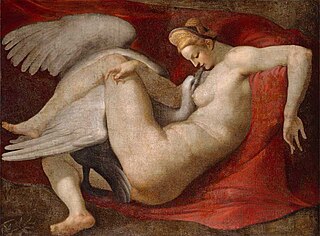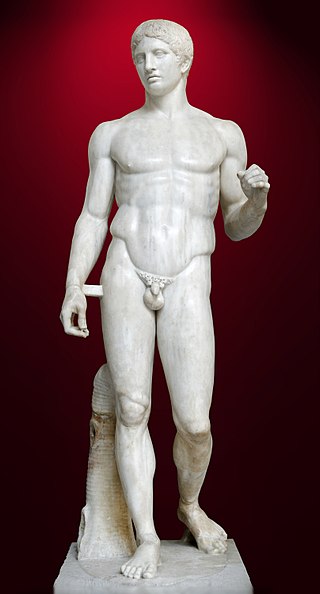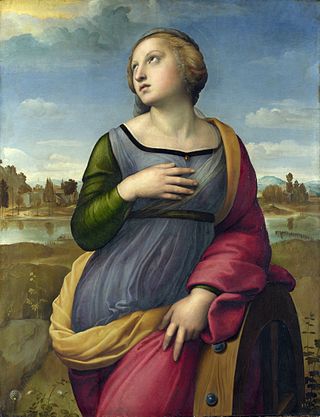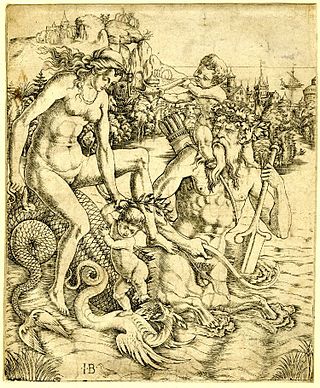
Leonardo di ser Piero da Vinci was an Italian polymath of the High Renaissance who was active as a painter, draughtsman, engineer, scientist, theorist, sculptor, and architect. While his fame initially rested on his achievements as a painter, he also became known for his notebooks, in which he made drawings and notes on a variety of subjects, including anatomy, astronomy, botany, cartography, painting, and paleontology. Leonardo is widely regarded to have been a genius who epitomized the Renaissance humanist ideal, and his collective works comprise a contribution to later generations of artists matched only by that of his younger contemporary, Michelangelo.

Leda and the Swan is a story and subject in art from Greek mythology in which the god Zeus, in the form of a swan, rapes Leda. According to later Greek mythology, Leda bore Helen and Polydeuces, children of Zeus, while at the same time bearing Castor and Clytemnestra, children of her husband Tyndareus, the King of Sparta. According to many versions of the story, Zeus took the form of a swan and raped Leda on the same night she slept with her husband King Tyndareus. In some versions, she laid two eggs from which the children hatched. In other versions, Helen is a daughter of Nemesis, the goddess who personified the disaster that awaited those suffering from the pride of Hubris.

Contrapposto is an Italian term that means "counterpoise". It is used in the visual arts to describe a human figure standing with most of its weight on one foot, so that its shoulders and arms twist off-axis from the hips and legs in the axial plane.

Antonio Allegri da Correggio, usually known as just Correggio, was the foremost painter of the Parma school of the High Italian Renaissance, who was responsible for some of the most vigorous and sensuous works of the sixteenth century. In his use of dynamic composition, illusionistic perspective and dramatic foreshortening, Correggio prefigured the Baroque art of the seventeenth century and the Rococo art of the eighteenth century. He is considered a master of chiaroscuro.

Cecilia Gallerani, born in Siena, Republic of Siena, was the favourite and most celebrated of the many mistresses of Ludovico Sforza, known as Lodovico il Moro, Duke of Milan. She is best known as the subject of Leonardo da Vinci's painting The Lady with an Ermine. While posing for the painting, she invited Leonardo, who at the time was working as court artist for Sforza, to meetings at which Milanese intellectuals discussed philosophy and other subjects. Cecilia herself presided over these discussions.

Leonardo da Vinci was an Italian Renaissance painter and polymath who achieved legendary fame and iconic status within his own lifetime. His renown primarily rests upon his brilliant achievements as a painter, the Mona Lisa and The Last Supper, being two of the most famous artworks ever created, but also upon his diverse skills as a scientist and inventor. He became so highly valued during his lifetime that the King of France bore him home like a trophy of war, supported him in his old age and, according to legend, cradled his head as he died.

Saint Catherine of Alexandria is a painting by the Italian Renaissance artist Raphael. In the painting, Catherine of Alexandria is looking upward in ecstasy and leaning on a wheel, an allusion to the breaking wheel of her martyrdom.

Cesare da Sesto (1477–1523) was an Italian painter of the Renaissance active in Milan and elsewhere in Italy.

The story of Leda and the Swan was the subject of two compositions by Leonardo da Vinci from perhaps 1503–1510. Neither survive as paintings by Leonardo, but there are a number of drawings for both by him, and copies in oils, especially of the second composition, where Leda stands.

Richard Cockle Lucas was a British sculptor and photographer.

Giovanni Agostino da Lodi was an Italian painter who was active from c. 1495 to c. 1525.

La Scapigliata is an unfinished painting generally attributed to the Italian High Renaissance artist Leonardo da Vinci, and dated c. 1506–1508. Painted in oil, umber, and white lead pigments on a small poplar wood panel, its attribution remains controversial, with several experts attributing the work to a pupil of Leonardo. The painting has been admired for its captivating beauty, mysterious demeanor, and mastery of sfumato.
Leda and the Swan is a classical myth.

The Leonardeschi were the large group of artists who worked in the studio of, or under the influence of, Leonardo da Vinci. They were artists of Italian Renaissance painting, although his influence extended to many countries within Europe.

The Madonna and Child with the Infant Saint John the Baptist is a lost composition by Leonardo da Vinci. The composition is known through a handful of paintings attributed to artists in Leonardo's circle. An original underdrawing by Leonardo may be preserved in a version in a private collection in Moscow, Russia.

Adolfo Venturi was an Italian art historian. His son, Lionello Venturi, was also an art historian.

Giovanni Battista Palumba, also known as the Master I.B. with a Bird, was an Italian printmaker active in the early 16th century, making both engravings and woodcuts; he is generally attributed with respectively 14 and 11 of these. He appears to have come from northern Italy, but later worked in Rome. He specialized in subjects from classical mythology, as well as the inevitable religious subjects. Despite his relatively small output, he was a sophisticated artist, whose style shows a number of influences and changes, reflecting awareness of the currents in artistic style at the start of the High Renaissance. The signed prints are usually dated to around 1500–1511.

Kneeling Leda with Her Children is a 16th-century painting by Leonardo da Vinci's pupil Giampietrino. It is now in the Gemäldegalerie Alte Meister (Kassel).

Leda and the Swan is a c.1505-1507 oil and resin on panel painting by a painter in the circle of Leonardo da Vinci. It may have originated in the Gualtieri Collection in L'Aquila and passed through various others before being acquired from the Spiridon Collection in 1989 by its present owner, the Uffizi.

Leda and the Swan is a tempera grassa on panel painting by an artist from the circle of Leonardo da Vinci, probably Cesare da Sesto. It dates to c.1510-1520 and is now in the Galleria Borghese in Rome. It and other versions at Wilton House and the Uffizi are considered the three best copies after Leonardo's own lost Leda and the Swan.



















